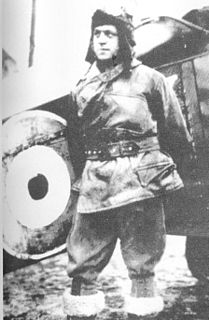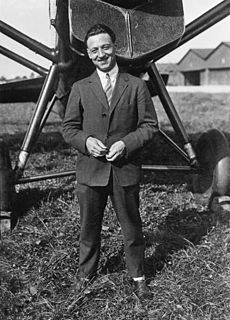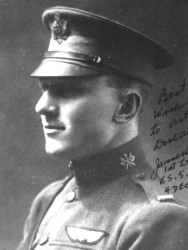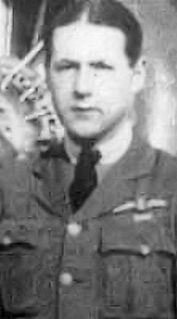
Frank Luke Jr. was an American fighter ace credited with 19 aerial victories, ranking him second among United States Army Air Service pilots after Captain Eddie Rickenbacker during World War I. Luke was the first airman to receive the Medal of Honor and first USAAS ace in day. Luke Air Force Base, Arizona, a United States Air Force pilot training installation since World War II, is named in his honor.
This is a list of aviation-related events from 1918:

William C. (Bill) Lambert was an American fighter pilot who flew in World War I. He was probably the second-ranking American ace of World War I. He claimed 18 air-to-air victories, eight fewer than "Ace of Aces" Eddie Rickenbacker and was awarded the Distinguished Flying Cross.

Oliver Colin LeBoutillier was an American aviator and flying ace. Serving with the British Royal Naval Air Service and Royal Air Force in the First World War, LeBoutillier scored 10 aerial victories, witnessed the death of Manfred von Richthofen and was a vigorous proponent of Captain Roy Brown as the victor over Richthofen. Post war, he became a stunt pilot for movies, a skywriter, and an aviation instructor whose most famous student was Amelia Earhart. Later, he became a civil aviation inspector.

Andrew King Cowper, was an Australian fighter pilot and flying ace of the First World War. Born in Bingara, New South Wales, he was educated in the United Kingdom at Eastbourne College. Joining the Royal Flying Corps in May 1917, he was posted to No. 24 Squadron RFC in France and was credited with shooting down nineteen German aircraft between November 1917 and March 1918. Cowper was awarded the Military Cross and two Bars during the war for his efforts in destroying German aircraft, in addition to carrying out ground-attacks. He was posted to the Home Establishment in April 1918, serving out the remainder of the war in the United Kingdom; he was discharged in 1920. Returning to Australia, he established his own horticultural business. He served in the Royal Australian Air Force in the Second World War, and died on 25 June 1980 aged eighty-one.

Lieutenant Lawrence Kingsley Callahan was a World War I flying ace credited with five victories.

Lieutenant Orville Alfred Ralston was a World War I flying ace credited with five aerial victories. He returned to service for World War II, only to die in a B-17 crash.

Lieutenant Hilbert Leigh Bair began his service career as a World War I flying ace credited with six aerial victories.

Lionel Alexandre Pierre de Marmier was a World War I flying ace credited with six confirmed aerial victories in World War I. He remained involved in aviation postwar, setting flying records and serving in the Spanish Civil War. At the start of World War II, he returned to his nation's service, shooting down at least one German plane. He died in an air crash on 30 December 1944. He was posthumously promoted to General.
Major Victor Henry Huston was a World War I flying ace credited with six aerial victories. He was the only ace in his squadron.

Lieutenant James Alfred Keating was an American World War I flying ace credited with six aerial victories, including four triumphs during a running battle on 9 August 1918.
Captain Wilfred Beaver was a World War I flying ace credited with 19 aerial victories.
Captain Ian Donald Roy McDonald was a British World War I flying ace credited with 20 aerial victories. Although born in the British West Indies, he returned to England to serve in the air force. After his successful career in combat, he spent a short time at home before returning to the colours. He served in Iraq postwar, and was executed there by insurgents.
Lieutenant D'Arcy Fowlis Hilton was a Canadian-born American World War I flying ace credited with eight aerial victories.

Lieutenant Kenneth Russell Unger was an American World War I flying ace credited with fourteen aerial victories. His candidacy rejected by his own nation, Unger applied to the British Royal Flying Corps for military pilot training in June 1917. Once trained, he was assigned to the Royal Naval Air Service (RNAS). As the RNAS was merged into the Royal Air Force, Unger scored his aerial victories between 26 June and 1 November 1918. In later life, Unger remained involved in aviation and served again during World War II. He also joined the U.S. Navy Reserves, rising to the rank of rear admiral.

First Lieutenant Paul Frank Baer was an American World War I flying ace credited with nine confirmed victories and seven unconfirmed victory claims. Although not the first American flying ace, he was the first ace flying for American military aviation. He also scored the initial victory for an American military unit.
Captain George Henry Hackwill was an English World War I flying ace credited with nine aerial victories. His most notable victory was his role in shooting down a German Gotha G.V, over Essex on the night of 28 January 1918. This was the first victory ever achieved in combat between aircraft at night.
Lieutenant Ronald William Turner, was an English World War I flying ace. He was credited with nine aerial victories while flying as an observer/gunner in two-seater fighters.

Lieutenant Frederick Ernest Luff was an American flying ace during World War I. He was credited with five aerial victories, and awarded the British Distinguished Flying Cross.
This page is based on this
Wikipedia article Text is available under the
CC BY-SA 4.0 license; additional terms may apply.
Images, videos and audio are available under their respective licenses.











